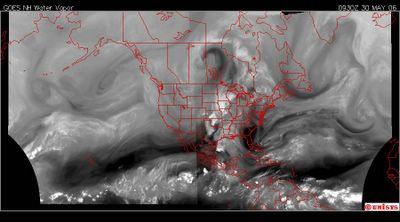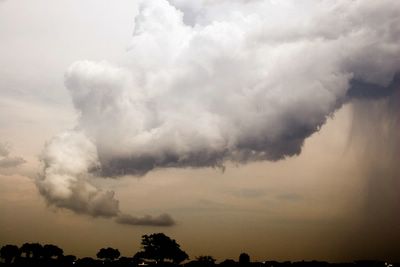 May 29, 2006. Buffalo, Okalhoma.Photographer states :: We were treated to a lot of lightning tonight, unfortunately the rain was East of us again.To illustrate the elusiveness of the 'rain' and the dominance of the lower troposphere it is noted this photographer is suffering in drought from rain. The 'intensity' of the storm is under the 'path' of the vortex. The dominance of the trospheric aire masse is still the controlling factor of the CLIMATE of Earth. The vortices are a manifestation of 'heat relief' of the lower troposphere that has resilience against 'incorporating' the heat rather than shunting it out of it's biotic layer. The Human Induced Global Warming is COMPLETELY reversible. As a matter of fact, Earth's trophosphere demands it !
May 29, 2006. Buffalo, Okalhoma.Photographer states :: We were treated to a lot of lightning tonight, unfortunately the rain was East of us again.To illustrate the elusiveness of the 'rain' and the dominance of the lower troposphere it is noted this photographer is suffering in drought from rain. The 'intensity' of the storm is under the 'path' of the vortex. The dominance of the trospheric aire masse is still the controlling factor of the CLIMATE of Earth. The vortices are a manifestation of 'heat relief' of the lower troposphere that has resilience against 'incorporating' the heat rather than shunting it out of it's biotic layer. The Human Induced Global Warming is COMPLETELY reversible. As a matter of fact, Earth's trophosphere demands it ! 
 May 29, 2006. Senatobia, Mississippi. This picture is enhanced for easier viewing. Photographer states :: High winds carried off our my sisters trampoline.I did not have time to focus.The photographer in referring to 'focus' is referring to the camera lens. The 'focus' of the photographer is more correct than any satellite orbiting Earth.
May 29, 2006. Senatobia, Mississippi. This picture is enhanced for easier viewing. Photographer states :: High winds carried off our my sisters trampoline.I did not have time to focus.The photographer in referring to 'focus' is referring to the camera lens. The 'focus' of the photographer is more correct than any satellite orbiting Earth.
 May 30, 2006. 0930z. Current water vapor satellite from UNISYS. Click on above link for 12 hour loop. Thank you UNISYS.The vortex is at higher altitudes from the other air movement. The underlying air movement is primarily the same from west to east. The 'vortices' culminate at much higher altitudes nearing the lower stratosphere and 'ionically charged' by elemental carbon and oxygen at the interface of the stratosphere and troposphere. Over the years since the manifestation of the first vortex of October 4, 2002 the intermingling of gases has become nearly a 'layer' of air all by itself where these monsters call home.
May 30, 2006. 0930z. Current water vapor satellite from UNISYS. Click on above link for 12 hour loop. Thank you UNISYS.The vortex is at higher altitudes from the other air movement. The underlying air movement is primarily the same from west to east. The 'vortices' culminate at much higher altitudes nearing the lower stratosphere and 'ionically charged' by elemental carbon and oxygen at the interface of the stratosphere and troposphere. Over the years since the manifestation of the first vortex of October 4, 2002 the intermingling of gases has become nearly a 'layer' of air all by itself where these monsters call home.
 May 29, 2006. Senatobia, Mississippi.Photographer states :: Bye, bye trampoline. High winds carried off our my sisters trampoline.
May 29, 2006. Senatobia, Mississippi.Photographer states :: Bye, bye trampoline. High winds carried off our my sisters trampoline. 
 May 30, 2006. 0630z.UNISYS Water Vapor Satellite of the North and West Hemisphere. The vortex appears as a huge question mark in the middle of the North American Continent.
May 30, 2006. 0630z.UNISYS Water Vapor Satellite of the North and West Hemisphere. The vortex appears as a huge question mark in the middle of the North American Continent.
 May 28, 2006.Lusk, Wyoming.It's on the ground. There isn't a big debris field yet. The 'reach' of this tornado extends all the way to the horizon. Follow the cloud bank behind it.
May 28, 2006.Lusk, Wyoming.It's on the ground. There isn't a big debris field yet. The 'reach' of this tornado extends all the way to the horizon. Follow the cloud bank behind it.

 May 30, 2006. 0330z. The vortex is forming. This was six hours ago. The center is north of the Canadian border. That is a 'direct' result of a very hot Gulf of Mexico.
May 30, 2006. 0330z. The vortex is forming. This was six hours ago. The center is north of the Canadian border. That is a 'direct' result of a very hot Gulf of Mexico. 
 May 28, 2006. Lusk, Wyoming Hail Storm. Photographer states :: Temperature dropped from 80 deg F to 34 deg F, 2
May 28, 2006. Lusk, Wyoming Hail Storm. Photographer states :: Temperature dropped from 80 deg F to 34 deg F, 2
 May 30, 2006. 0030z. Nine hours ago.
May 30, 2006. 0030z. Nine hours ago.
 May 29, 2006. Prosper Texas.The 'rain/downpour' is ot the right in this photo. Photographer states :: A storm in north Texas today took on a life of it's own. This cloud extended down from the base of the thunderstorm and was visibly twisting around itself. It was incredible to see.IT'S GOIN' TA BE BAD ! Stuff no one has seen before. The 'heat' in the south already is in the 90s.
May 29, 2006. Prosper Texas.The 'rain/downpour' is ot the right in this photo. Photographer states :: A storm in north Texas today took on a life of it's own. This cloud extended down from the base of the thunderstorm and was visibly twisting around itself. It was incredible to see.IT'S GOIN' TA BE BAD ! Stuff no one has seen before. The 'heat' in the south already is in the 90s. 
 May 29, 2006. 2103z. The Water Vapor Satellite of UNISYS of the North and West Hemisphere. The 'heat' transfer from the 'Gufl' is rather intense. Those would be the big white spots. There had to be some dangerous weather under those. This is an image from twelve hours ago.
May 29, 2006. 2103z. The Water Vapor Satellite of UNISYS of the North and West Hemisphere. The 'heat' transfer from the 'Gufl' is rather intense. Those would be the big white spots. There had to be some dangerous weather under those. This is an image from twelve hours ago. 
 "Heads Up"We are off and running. This is 'exactly' the location of every Pacific storm that accompanied any Atlantic storm, including Katrina, that arrived on terra firma last year. I am not surprised the first manifestations of storms this year starts there.
"Heads Up"We are off and running. This is 'exactly' the location of every Pacific storm that accompanied any Atlantic storm, including Katrina, that arrived on terra firma last year. I am not surprised the first manifestations of storms this year starts there.
MEXICO CITY – Tropical Storm Aletta, the first tropical storm of the eastern Pacific season, was stalled Monday about 165 kilometers (102 miles) southwest of Acapulco.
Forecasters issued a tropical storm warning from Punta Maldonado northwestward to the beach resort of Zihuatanejo, warning that the storm could bring heavy rainfall, flash flooding and mudslides to the mountainous coastline.
However, the storm was expected to begin inching farther out to sea.
Maximum sustained winds were at 75 kph (45 mph) and some strengthening was expected, according to a report by the U.S. National Hurricane Center in Miami.













